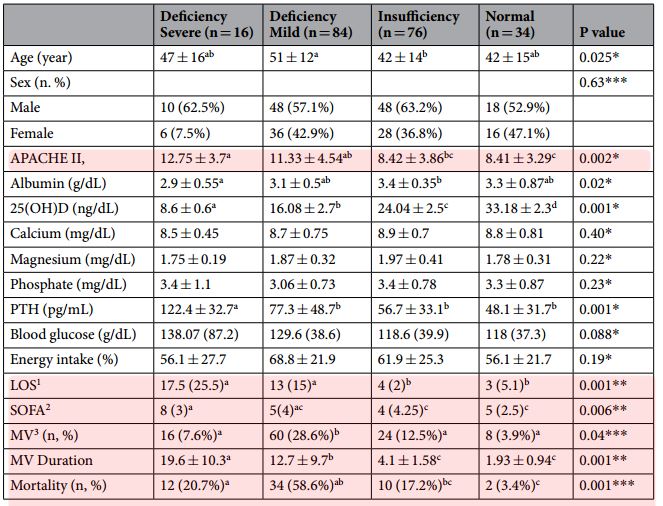Neurosurgical ICU patients critically low on Vitamin D
Association of admission serum levels of vitamin D, calcium, Phosphate, magnesium and parathormone with clinical outcomes in neurosurgical ICU patients
Scientific Reports | (2018) 8:2965 DOI:10.1038/s41598-018-21177-4
Seyed Hossein Ardehali1, Salman Dehghan2, Ahmad Reza Baghestani3, Aynaz Velayati2 & Zahra Vahdat Shariatpanahi2
Download the PDF from VitaminDWiki
To evaluate the association of admission serum levels of 25(OH)D, parathormone and the related electrolytes with severity of illness and clinical outcomes in neurosurgical critically ill patients, serum levels of 25(OH)D, parathormone, calcium, magnesium, and phosphate, along with APACHE II score were measured for 210 patients upon admission. Mean serum 25(OH)D was 21.1 ± 7.4 ng/mL. 25(OH)D deficiency (less than 20 ng/dL) and elevated serum parathormone level were found in 47.6% and 38% of patients respectively. Hypocalcaemia, hypophosphatemia, hypomagnesaemia and hypermagnesaemia were found in 29.5%, %63.8, 41.9% and 27.6% of patients respectively. The APACHE II score was significantly correlated with serum levels of 25(OH)D, parathormone, calcium, and phosphate. Multivariate regression analysis adjusted by other risk factors showed that among all clinical outcomes, admission hypovitaminosis D was associated with longer duration of ICU stay and a high admission of parathormone was associated with in ICU mortality. We concluded that disorders of admission serum levels of 25(OH)D, parathormone, calcium, magnesium, and phosphate are related to the presence of multiple causal factors such as severity of disease and are not independently associated with clinical outcomes. Most often they are normalize spontaneously with resolution of the disease process.

Table 1. Characteristics of patients based on 25-hydroxyvitamin D categorized groups.
- One-way ANOVA (mean ± SD), Man-Whitney (median, IQ), *Chi square.
1 LOS Length of stay,(days in hospital)
2 SOFA Sequentional organ failure assessment,
3 NV Mechanical ventilation.
Values with diferent superscript letters are signifcantly diferent.
